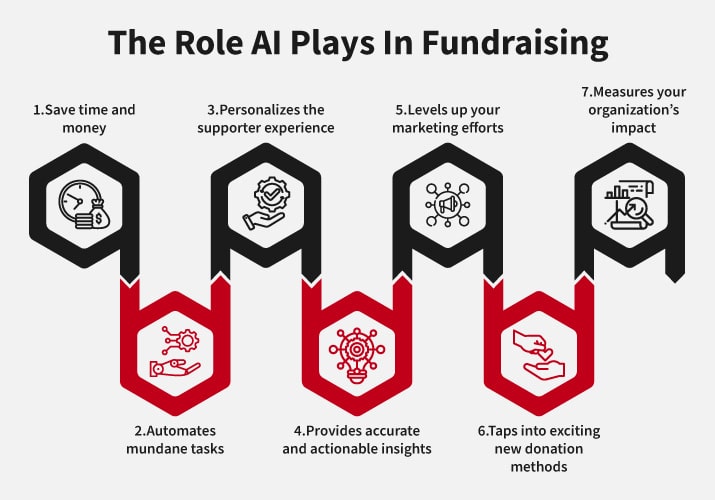
Leveraging AI for Higher Ed Fundraising: A Quick Explainer

As higher education fundraising adapts to contemporary donors’ expectations, one notable trend is the growing popularity of artificial intelligence (AI) fundraising tools. These advanced solutions can help colleges and universities like yours learn more about your donors, build stronger relationships with them, and tailor your outreach efforts to secure more funding.
However, there may be concerns at your institution about how AI will impact your operations, or you may just be curious about how to best utilize AI to support your specific university fundraising strategy. Either way, this guide is for you! We’ll cover everything you need to know about leveraging AI for higher ed fundraising, including:
- AI Fundraising: An Overview
- 4 Ways to Use AI in Higher Ed Fundraising
- A Note on Leveraging AI Responsibly
Before we dive into how to take your technology-based fundraising efforts to the next level with AI, let’s get started by reviewing what exactly AI fundraising entails.
AI Fundraising: An Overview
According to DonorSearch, “Artificial intelligence (AI) is the ability of a machine (like a computer) to ‘think’ like a human and perform tasks like recognizing patterns, processing information, drawing conclusions, and making recommendations.” AI fundraising, therefore, refers to the way organizations leverage solutions with these abilities to bring in donations.
AI fundraising tools can provide a wide range of benefits for higher education institutions, such as:

- Saving time and money through more targeted activities
- Automating mundane tasks so you can focus on more important work
- Personalizing the supporter experience
- Providing accurate and actionable insights
- Leveling up your marketing efforts
- Tapping into exciting new donation methods
- Measuring your organization’s impact to help with goal-setting
There are two main types of AI solutions your institution might leverage for fundraising. Generative AI tools like ChatGPT and DALL-E create written or visual content in response to prompts, which you can then incorporate into your communications. Predictive AI tools like DonorSearch Ai (which integrates with Salesforce and is available on the AppExchange) process and analyze data to identify trends and make suggestions for future fundraising actions.
4 Ways to Use AI in Higher Ed Fundraising
Now that you know what fundraising AI is and how it can benefit your institution, let’s look at four ways to leverage it that are particularly relevant for colleges and universities.
1. Conducting Prospect Research
Prospect research is the process of identifying potential high-impact donors for your institution. The more intelligent your fundraising tools are, the more likely you are to find donors who are able and willing to give the significant gifts your college or university needs to educate its students, conduct research, grow its campus, and more.
Start your prospect research by reviewing the data stored in your usual prospect research tools—your university’s CRM system, third-party databases, and resources like SEC and FEC records. Then, use a predictive AI fundraising solution to process that data and, through a process known as predictive modeling, make recommendations about who your top prospects are and how best to engage each of them.
2. Managing Donor Data
Your institution likely collects a lot of data on its supporters, whether through prospect research, donation processing, or tracking responses to marketing messages. This data is only useful for decision-making if it’s accurate and organized, which is where AI comes in. Use your AI tools to:
- Sort through data sets and purge any duplicate or incomplete information.
- Integrate data from multiple sources to get a complete picture of your donors.
- Detect security threats so you can stop data breaches before they cause problems.
- Generate data visualizations to help you draw actionable conclusions.
The more data your institution collects, the more important it is for you to be able to manage it at scale. Rather than having a staff member spend hours combing through spreadsheets or software records, AI can do the heavy lifting for you!
3. Creating More Impactful Marketing Content
Brainstorming, developing, and sending out communications can be time-consuming for busy higher ed fundraising professionals like you. Fortunately, AI tools can take some of that burden off your shoulders. For instance, you can use them to:
- Generate suggestions for certain aspects of your content, such as email subject lines, social media captions, and text message copy.
- Automate your marketing messages so that donors receive them at the exact time when they’re most likely to engage with them.
- Add a chatbot to your university fundraising website to help visitors find what they’re looking for without the need for a person to monitor the site 24/7.
Whenever you use AI to create marketing content, make sure someone on your team looks it over and revises it so it aligns with your institution’s brand and retains the human touch that donors will appreciate.
4. Personalizing Fundraising Asks and Thank-Yous
According to eCardWidget, personalized messages reassure donors that you see them as more than just their gifts, helping to strengthen your relationships with them and retain their support. However, as your institution’s fundraising strategy grows, it can be challenging to find the time to personalize every solicitation and thank-you note.
Leverage your predictive AI tools to develop fundraising asks that donors are likely to be receptive to based on their giving history and communication preferences. Generative AI can also be useful in developing templates for solicitations and thank-yous that you can customize with each donor’s name, donation amount, and interests. This way, you can automate the rote parts of the process and spend more time getting to know your donors on a personal level.
A Note on Leveraging AI Responsibly
If there are concerns about AI at your college or university, they’re likely related to its ethical implications. Thankfully, your institution has no need to fear as long as you commit to use AI responsibly. To do so, pledge to ensure:
- Privacy and security
- Data ethics
- Inclusiveness
- Accountability
- Transparency and explainability
- Continuous learning
- Collaboration with others in the fundraising space
- Legal compliance
- Positive social impact
- Sustainability
Although there are risks associated with using AI tools, your institution can safeguard against them by following these best practices. Plus, the many benefits of these solutions greatly outweigh the risks.
As you develop your higher education institution’s AI fundraising strategy, make sure everyone is on board with your commitment to responsible AI use and understands the best ways to leverage AI to achieve your goals. Track data on your progress and check in with your donors to identify the strengths and areas for improvement in your efforts over time.

